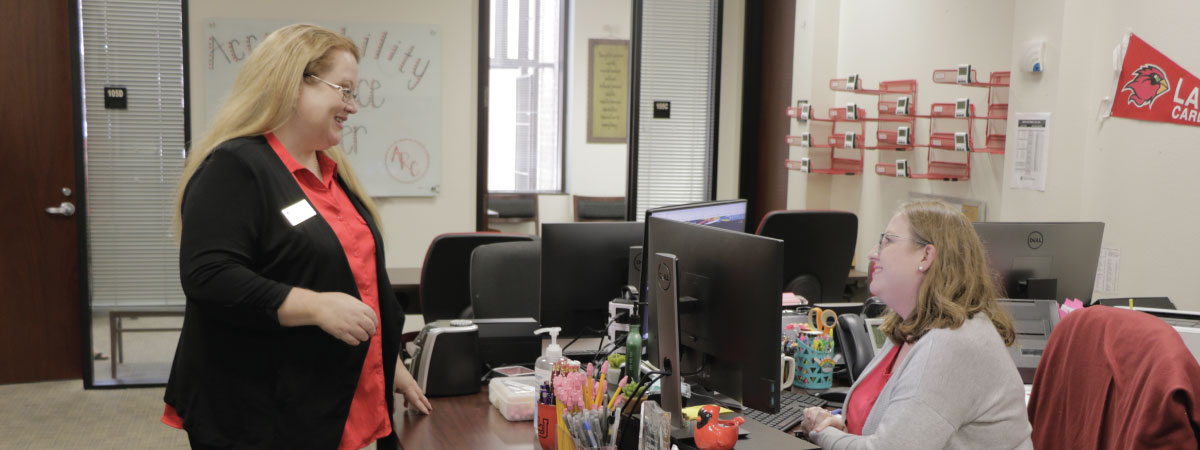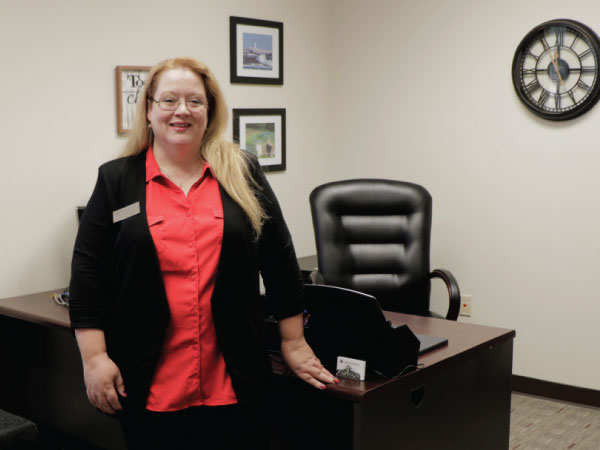A Q/A with LU’s new director for the Accessibility Resource Center

Tammy Lilly is the newly named director for the Lamar University Accessibility Resource Center, formerly referred to as the Disability Resource Center. Lilly, who earned her master’s degree in nursing from Lamar University in 2014, is a registered nurse and has worked in nursing education for more than 10 years.
The Accessibility Resource Center is a student-focused resource that works to determine and facilitate reasonable accommodations in compliance with the Americans with Disabilities Act and Section 504 of the Rehabilitation Act of 1973. The center also brings educational awareness to disability issues in hopes of creating positive experiences for future Cardinals.
It’s a mission that hits home for Lilly who became an expert in disability services after years of advocating for her son who also has disabilities.
We recently caught up with the new director to learn more about what services the department offers and how the ARC team works to serves the campus community.
Q: This is formally the Disability Resource Center. Can you explain how this department has evolved to better serve our campus community?
A: So, the Disability Resource Center is our former name and we joined the Division of Student Engagement in early 2022. We're so pleased to join that division because it's a division that brings together student-focused resources and collaboration with others. But as we were looking at some of the changes that we were making in joining our division, and then some of the leadership changes, we started to talk about the word disability and Disability Resource Center. We thought, ‘Is that a true representation of what we do here?’ Of course, we serve individuals and students with disabilities, but we really want it to be crystal clear.
Q: What is the mission of the Accessibility Resource Center?
A: Our purpose is to make sure that all of the student experience at Lamar University is accessible for our students. So, that's everything from your classes and activities to residence life. So, it's really important that we reflect in our name what it is that we do because we truly are doers here in this department and we want to be that resource for accessibility for our students. When we reach accessibility for everyone, then those barriers are removed and all aspects of their student experiences are equitable. When we looked at who we are and what we do, this is what best described us. We had a lot of brainstorming with staff, some of our students and then with other stakeholders of ‘Where should we go with this name and what best describes us?’ and we really felt the Accessibility Resource Center was the best description of who we are what we do.
Q: What types of services are offered? 
A: It's super important that students who have a disability self-identify and how they do that is they go to our website. So, once they go to the website, they're going to register and fill out an application with the Accessibility Resource Center. Those students will then upload some documentation and the application will provide them information on what to upload. Then, they'll have an individualized intake meeting with me or our interim assistant director, where we really discuss with that student what's going on with them: how their disability impacts their student experience; how it was in the past; how they predict it may impact them in the future; and we also add our knowledge and expertise into knowing what might be a barrier moving forward. So, we have that discussion and then we start to talk about something called accommodations and what accommodations are is an opportunity for us to put some measures in place that level the playing field for those students that really help remove some of the barriers. For example, they talk about course-related barriers, so student classwork, but also some of the activities and residence life that may exist for that student. For some students, it may be very, very, simple. For others, it is very complex, but it's really an interactive process that we go through with that student and it's very individualized to their needs.
Q: What are some of the most common barriers that you see from students?
A: A very common barrier is a communication access barrier. We do serve students who are Deaf, or Hard of Hearing, here on campus so considering communication access for those students and for some students that may require an American Sign Language interpreter. For other students, it may be something like captioning of classes. Other students experience barriers that may be time related or the way that the material is delivered. Students with learning disabilities or students with other types of disabilities, to which time is really an enemy of them, may need some extended testing time to get through some of that material. So, not specifically test anxiety because test anxiety is not a diagnosis that the ADA recognizes as a disability, but certainly generalized anxiety, depression, aattention-deficit/hyperactivity disorder and those types of things. And then we have other students who may have barriers that you more traditionally think of with disability. Perhaps we have someone with a physical disability, but then we need to consider ‘Should there be some particular seating in a classroom? Are our buildings as accessible as they should be?’ So, those are the types of things that we look at for our students.
Q: When it comes to breaking down barriers for our students with any form of disability, how has technology played a part in that?
A: It's huge, and I'll tell you what, COVID-19 was a double-edged sword. We learned a new way of doing. There were things that we thought were next to impossible. When we had COVID-19, we learned to think outside the box even more than we ever have. We've pushed people who may not have been comfortable stepping outside the box to embrace those technologies. It's really important that not only do we serve our students with disabilities with technology, but that every student is served with technology. So, we really need to work to remove barriers for everyone. For example, closed captioning for all videos, making sure that when we're in the classroom we're not dimming the lights so that everyone can see both the faculty member as well as anything that's presented because you may have someone that has a visual disability, that is unable to see things.
Q: What do you think are good practices for students in approaching faculty to talk about their accommodations needs?
A: Faculty are notified via e-mail when their students register with the ARC and activate accommodations. The student initiates this communication via the ARC’s electronic system called AIM. Faculty also have access the AIM system to view a list of students in their course with accommodations. It’s important for everyone to know that faculty do not receive disability specific information on their students, this information remains confidential within the ARC. We do encourage our students to discuss how specific accommodations may be implemented with each course instructor, but they are not required to do so. Some students may find it difficult to have these one-on-one conversations so our official communication is via e-mail.
Accommodations are not retroactive –– they can be activated by the student at any time after their intake with the ARC and should be implemented within 24-hours of the e-mail notification. If a faculty member has a question or concern about an accommodation, we encourage them to reach out to the ARC to discuss the situation. It’s also important for faculty members to refer any student who requests a disability related course modifications to the ARC because the student may not be aware of the process here at Lamar University. During this semester, to ensure everyone can reach us as we transition from the Disability Resource Center to the Accessibility Resource Center, both names are searchable in the LU website and our old e-mail address is redirected to arc@lamar.edu.
Q: What do you wish students knew about asking for accommodations that they maybe don’t already know?
A: I wish that students knew to reach out because students at the university level have to self-identify with a disability and they have to reach out for that resource –– unlike high school years where the school and their parents were in control of the ship guiding it and steering them in the right direction. So, they have to reach out and once they reach out its understanding that it's not one size fits all. We're going to have those individual conversations with them and we're going to figure out for them, ‘What are the barriers and how do we overcome them?’
Q: What is your future vision for the ARC?
A: I really want to reach all of the students that need us. I want to make sure that they know that we're here for them so that they can reach out. But I also want to reach all of the students at LU and encourage the university as a whole community to embrace accessibility because when we embrace accessibility, everyone is going to benefit from that.
Learn more about the Accessibility Resource Center